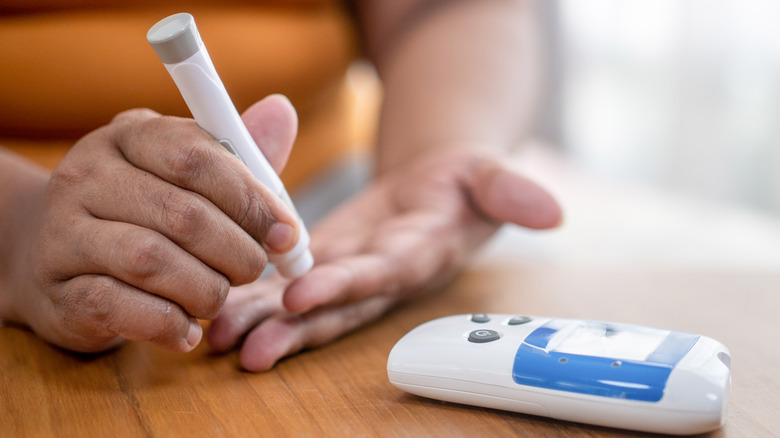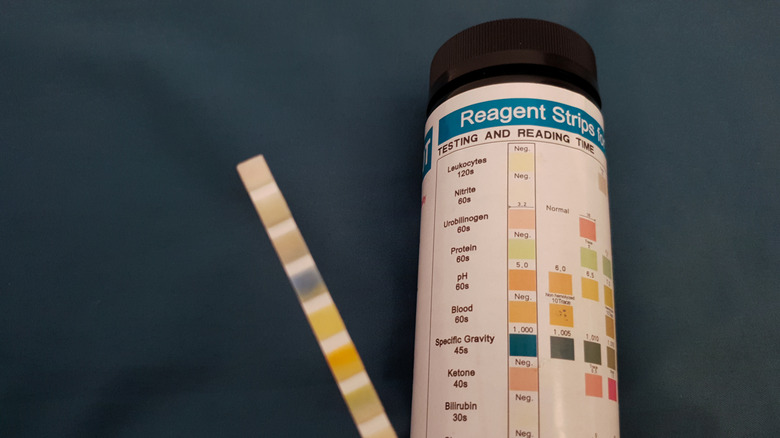The Diabetes Complication That Can Ultimately Lead To Death If Left Untreated
Your body needs energy from food to perform essential functions such as producing hormones, fueling physical activity, and keeping your heart and brain working properly. When you eat, your body breaks down the food and extracts nutrients to use for specific purposes. Carbohydrates in your food are converted into glucose, which is then released into your bloodstream. In response, your pancreas secretes insulin, a hormone that helps move glucose into your cells for energy and lowers the amount of sugar in your blood.
People with diabetes either don't produce enough insulin or can't use it effectively to regulate blood sugar. As a result, glucose can build up in the bloodstream while the body's cells remain starved for energy. One life-threatening complication of diabetes is diabetic ketoacidosis (DKA), which occurs when cells are so deprived of glucose that the body begins breaking down fat stores for energy.
While this might sound beneficial for someone trying to lose weight, in DKA, the liver produces an excessive amount of ketones, which are byproducts of fat metabolism. Too many ketones in the bloodstream can cause the blood to become dangerously acidic. Left untreated, this drop in pH can be toxic and may lead to coma or sudden death.
Diabetic ketoacidosis is more common with type 1 diabetes
Type 2 diabetes is far more common in the United States and can lead to complications such as nerve damage, kidney disease, blood vessel problems, and even dementia. Type 1 diabetes accounts for less than 10% of all diabetes cases, according to the U.S. Centers for Disease Control and Prevention. While people with type 2 diabetes may eventually need insulin to manage their blood sugar, those with type 1 diabetes must take insulin every day to survive. Without a constant supply of insulin, people with type 1 diabetes are at risk for DKA. DKA is rare in people with type 2 diabetes because they typically still produce some insulin, which helps prevent ketone buildup.
(Read about an insulin pill that may treat type 1 diabetes.)
DKA can occur when a person's insulin supply is disrupted, whether due to missed injections, problems with an insulin pump, or incorrect dosing. Being sick can also raise the risk of DKA because it may be hard to control blood sugar due to an inconsistent eating and drinking schedule. Other triggers include alcohol or drug use, certain medications, or serious medical events like a heart attack.
Symptoms and prevention of diabetic ketoacidosis
DKA develops gradually, so it's important to catch early symptoms before it becomes severe. As blood sugar and ketone levels rise, early signs can include unusually frequent urination and excessive thirst. If left untreated, DKA can lead to extreme fatigue, trouble concentrating, dry skin, nausea, shortness of breath, and breath that smells fruity.
If you have type 1 diabetes and notice these symptoms, the American Diabetes Association urges you to call your doctor or go to the emergency room. Treating DKA typically involves replacing fluids and electrolytes you've lost, and you may be given insulin to bring your blood sugar back to safer levels. If an underlying illness or infection triggered the DKA, you may also need medication to treat that condition. By the way, it can also be life-threatening if you take too much insulin.
To help prevent DKA, people with diabetes should regularly check their blood sugar to make sure it stays within the target range set by their healthcare team. If your blood sugar is over 240 mg/dL, it's a good idea to check for ketones, especially if you're feeling any symptoms. You can test your ketone levels at home with an over-the-counter urine test kit. It's also important to check your ketones every few hours if you're sick, particularly if you're not eating normally.


